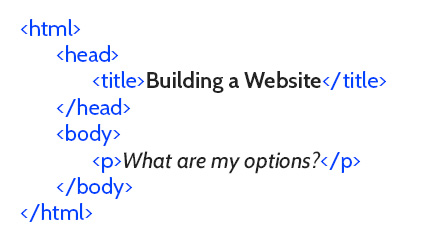The time has finally come: you are ready to invest into the building of a proper website for your business, product or brand. Congratulations! At this stage, you already understand the value of a website as a way to put your name out there, boost your sales and provide accessible information for your clients, prospects and/or fans. But here comes the big decision: What type of website will you get? And what are the options for you to choose from?
Static HTML/CSS website
All website start off as HTML and CSS; those languages are the structure that holds together your site and that makes it possible for your visitors to see colors, images, links and about just everything.
There are standards that define good and bad HTML and CSS practices, and all good web designers and programmers are (or should be) aware of them. A common example of a bad use of HTML is the use of tables; unless you are presenting tabular data, similar to an Excel sheet for instance, tables have no place in the basic structure of a website. Yet, some web designers do not take time to learn good practices and build websites which are not optimal structure-wise or even not compatible in all browsers. But I digress…
A static HTML/CSS website is a promise of a presentable site with several pages, but it is, as the name hints, static. Unless you know your way around HTML and CSS, you will be dependent on your web designer to update its content. And there lies the issue if you plan on adding content on a fairly regular basis. On all other aspects, a static HTML/CSS website, when well coded, is a fair option.
Flash website
Flash websites used to be a big hit a few years back; now, not so much. The reason is simple; many mobile devices such as smartphones and tablets do not render Flash. In fact, Adobe released a few months ago an announcement that confirms they will no longer be providing updates for Android devices. That pretty much signs the death of Flash websites.
Flash websites easily be identified; besides the “update your Flash plugin” message you get when you visit the page (haha) you will often hear sound effects and see Power Point-like animations. Flash sites are great for games and video-based websites. A great use of them is for new movie websites which often feature animated previews as backgrounds. The technology is also still (unfortunately) very commonly used for architectural projects and condominium rental websites.
If you want a website loaded with effects and transitions that cannot be reproduced with JavaScript (a great add-on to HTML and CSS, also compatible with mobile browsers), Flash may be what you need. Otherwise, my advice as a web designer is to stay away from it.
Using WordPress or other CMS
WordPress is the best thing since the invention of the internet. Alright, one of the best things. CMS stands for “Content Management System”; built in PHP, it makes your HTML/CSS page manageable and easy to update. Although I strongly recommend WordPress, the most popular CMS out there, there exist other options like the heavier but powerful Joomla or Drupal.
What all CMS have in common is a user-friendly interface which registered users can access in order to modify and/or add new content and images to the website. A CMS is ideal for a website which possesses a blog, a portfolio or that encourages user participation (i.e. commenting or submission system).
Building a WordPress website consists of taking a static HTML/CSS page, create a template out of it, and then integrate it to CMS. It requires an extra step but for any website owners who want autonomy and a dynamic website which will attract more visitors and search engines it’s completely worth it. Also take note that CMS are extremely flexible and can be made into almost anything, so long your web designer or developer has the technical knowledge.
Facebook, Twitter, Google+ and other social networks
A presence on the major social networks in 2012 is a must for a business, brand or product. It can help gain followers, new clients and it can also be a platform for users to leave feedback. Therefore, having a page on Facebook, Google+, Linkedin and an account on Twitter cannot hurt. Should a business limit itself to those though? No.
Social networks, unlike websites, limit the content and images which appear on their pages. Tumblr is an example of a flexible social blogging site/community, however it limits the type of uploaded content as well as the user interaction. A company that restrains itself to social media will face some trouble building a serious brand. As a companion to your website however, social networks are terrific.
Conclusion
Here is a condensed version of everything above (for all the tl;dr people out there): If you want a website that you will never ever update, go for a static HTML/CSS. If you want a website with crazy effects and sounds, and you don’t care that 20% of the world will not be able to visit your website, go with Flash. If you want an easy-to-manage website with updatable content like a blog or a portfolio, adopt a CMS like WordPress. Finally, if you don’t care for a website (why are you reading this article is a mystery to me), stick with social networks; they’re limited but better than nothing.
